Art able to start a socially responsible transformation has taken the stage in Turin, in two atypical locations: dwellings. In the city centre there are in fact two structures where art is a “tenant” cohabiting with the residents living in them. Michelangelo Pistoletto visited these two peculiar buildings, interacting with people inhabiting them and talking with the artists and the creators of the project, who have made art live in residential spaces. Last Saturday, at 16.30, the artist from Biella went to the block of flats in via Cuneo 5 bis, where he met Andrea Quarello, the building manager, and Alessandro Bulgini, the neighbourhood artist – as he defines himself –, leading the project which has given the building a new lease of life. The two hosts talked about the history of the structure and the peculiarities of the works of art on display.

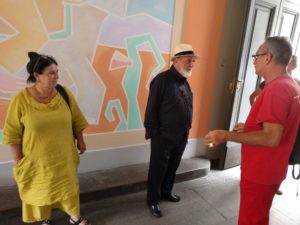
In the lobby, you’re immediately swamped with colours: the brightly painted walls and ceiling (see picture) welcome residents and their guests. Inside the courtyard, an unusable red ladder has been fixed with an artistic twist (see picture). In the building, everything is arty: climbing the stairs you can see pictures of the resident families on the walls, making them the protagonists of the creative context; from the first floor balcony you can see a colourful carpet recalling the variety of colours of the entrance hall.
The creativity of the neighbourhood artist has revived the building.
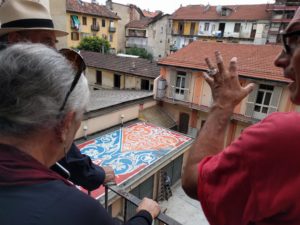
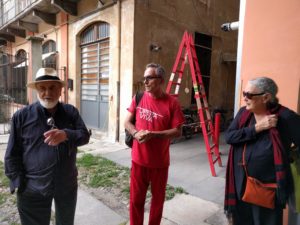
After this stop, at 17.30 Pistoletto was the special guest of the conference “From the creative collaborations to the Third Paradise – From the Venice Biennale (1968-2005) to the world and to the sideral space” at the Polo del ‘900, also in Turin. In the course of the event (please see the complete video below), curated by ISMEL – Institute for the Memories and Culture of Work, Enterprise and Social Rights in collaboration with Educational Department Castello di Rivoli, the artist from Biella dialogued with Anna Pironti (Director of the Educational Department Castello di Rivoli Museum of Contemporary Art) and Fortunato D’Amico (Cittadellarte’s collaborator). The initiative, as mentioned in a previous article, was the final stage of a series of events organized in the cultural centre with the coordination of the Piero Gobetti Study Centre, aiming at shedding light on1968 cross-analysing it through the perspectives of different guests.
(Video Credit: ISMEL)
As programmed, that particular year was discussed from an artistic point of view: Pistoletto, talking with Pironti and D’Amico, focused on that period of his career, which gave us some of his most famous works. The conversation ranged from his first self-portraits to the mirror paintings, from the Minus Objects to the artist’s first manifesto (on the occasion of the 1968 Venice Biennale). Pistoletto dwelled on the social role of art, that art of his able to connect with every social sector and to generate a responsible transformation of society itself. The three way dialogue then centred on the Venus of the Rags: Pistoletto, invited by D’Amico, explained its meanings, and Anna Pironti presented the project that has taken it to Ventimiglia. The last part of the conference was about demopraxia and the Third Paradise. The Director of the Educational Department Castello di Rivoli illustrated the story and the peculiarities of many representations inspired by the sign-symbol; D’Amico echoed her words, talking about the Forums in Cuba and the project Spac3.


(The conference at the Polo del ‘900)
After the event at the Polo del ‘900, Pistoletto visited “viadellafucina16”, the first condominum-museum in Europe (as mentioned in a previous article). Brice Coniglio, who conceived the artistic project, met the artist from Biella and told him about the characteristics of the structure and the milestones of the project it houses. Here as well, art has been able to produce a virtuous change: the building, located in the Porta Palazzo area in via La Salle 16, was reborn thanks to many different art forms created by the residents themselves.
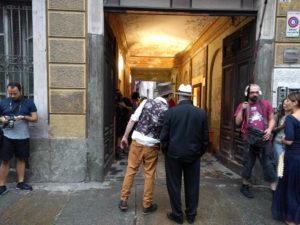
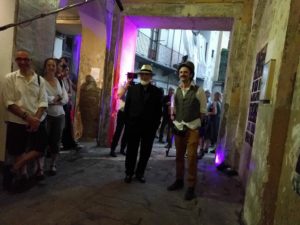
(Michelangelo Pistoletto and Brice Coniglio at the condominium-museum)
“The start of artistic practices by national and international artists aiming at regenerating shared spaces within an old and run down building – we read on the website of the condominium – represents an absolute model for anybody interested in exploring real actions of partecipative democracy today”. Pistoletto, after the visit, assisted to a performance curated by the artists Spagone and Navander and dedicated to him. He eventually left his mark as well: he drew his sign-symbol, the Third Paradise, on a mirror. Since last Thursday, the condominium-museum has had an extra work of art.
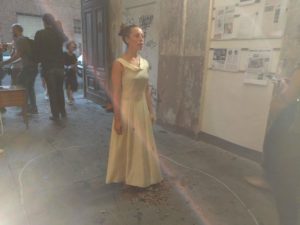
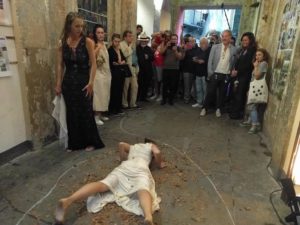
(The performance dedicated to the Third Paradise and to Pistoletto)

